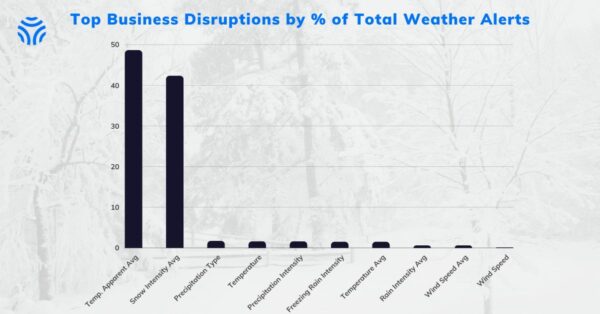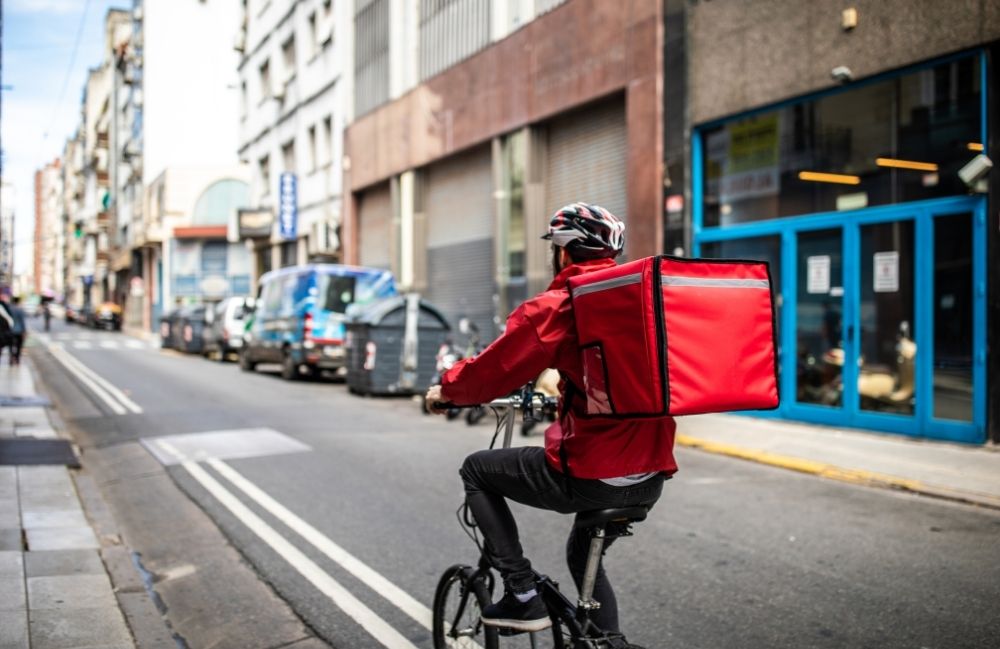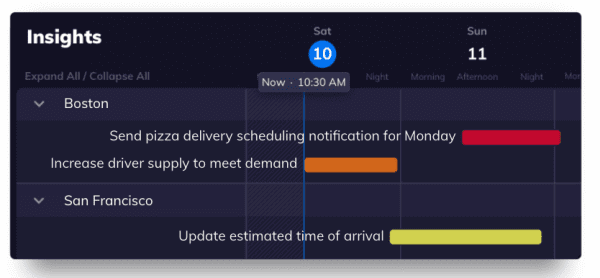Bad Weather & On-Demand Delivery Services
Inclement weather often triggers a surge in demand for on-demand delivery services. As rain, snow, or even excessive heat makes the idea of stepping out less appealing, consumers increasingly turn to the convenience of food delivery apps.
Whether you’re ordering from DoorDash, UberEats, GrubHub, or your local Dominos, certain weather conditions will have you choosing convenience for dinner. In this blog, we highlight the results of our survey on the impact of weather on pizza delivery and touch on how advanced weather technology is transforming on-demand food delivery services.
When Do Consumers Prefer to Order Food?
People love convenience and self-service. According to DoorDash’s Online Ordering and Restaurant Consumer Trends Report, ordering takeout and food delivery is very popular, and third-party apps, like DoorDash, are the preferred way to browse for food and order delivery. In fact, 34% of customers turn to a third-party app to order food delivery, a 10% increase from the year before.
Nearly 73% of people turn to food delivery in urgent situations, and 44% will order food from third-party apps 2-4 times a month. It would seem that consumers who like the convenience and familiarity of mobile food apps enjoy browsing for new menu items and restaurants.
Another contributing factor to increases in mobile app and online food delivery ordering? Extreme weather.
How Food Delivery Preferences Have Evolved
In 2020, we ran a survey on how bad weather impacts food delivery services.
That year, a lot more people were ordering pizza delivery. The financial impact on pizza delivery was pretty significant, and still continues to grow to this day.
In 2020, Domino’s reported $4.117B in revenue that year, a 13.78% increase from 2019. That same year, Domino’s added 39 new stores in the United States, in addition to another 45 new locations around the world. Since then, the growth has only continued.
What’s also interesting about the growth is where it came from — 65% of U.S. sales came from digital channels, while 50% of global sales were via remote channels. In other words, online ordering has become the main channel for pizza deliveries.
When you combine the surge in business with another year of unexpected and crazy weather all across the globe, things get complicated. In fact, on-demand and delivery margins are smaller than ever, with the weather having a significant impact on the food delivery industry.
To gain deeper insights into the state of the pizza and food delivery sector, we carried out a survey to examine the influence of weather patterns on the industry and to identify the most promising opportunities for stimulating customer expansion.
What we found isn’t surprising, but it is enlightening for on-demand and pizza delivery companies everywhere. And, in our opinion, it still holds true to this day.
Here are the results.
The Results: ETAs Matter Most
We surveyed an anonymous group consisting of the following:
- 277 Respondents
- Ages 18-50
- Located in the United States
- 60% Male and 40% Female
- Household Income of $100k – $150K
We asked respondents 5 questions:
- When the weather is bad (rain, snow, ice, cold…etc), how likely are you to order pizza delivery?
- How important is the expected delivery time when ordering pizza?
- If your pizza delivery is later than expected, how likely are you to consider a different restaurant next time you order delivery?
- Are you willing to pay more for faster pizza delivery?
- Would you like to get notifications on your phone when the weather will be bad so you can schedule pizza delivery in advance?
The results, as expected, were quite interesting.
The Competitive Delivery Advantage
Here are the core takeaways from our pizza delivery survey:
- 49% of people are more likely to order pizza delivery during bad weather
- 92% of people say expected delivery time is important to them (within the 92% group of respondents, 39% said it’s very important)
- If the actual delivery time is later than the expected arrival time, 69% of people are likely to consider a different restaurant the next time they order (within the 69% group of respondents, 19% said very likely)
- 32% of people are willing to pay more money for faster delivery
- 56% of people would like to receive notifications on their phone when the weather is going to be bad so they can schedule a pizza delivery in advance
How On-Demand Food Delivery Makes the Most of the Weather
The results shine a light on a few key findings.
First, the weather significantly impacts how people think about food delivery, with 49% of people saying they’re more likely to order delivery during bad weather.
Second, consumers seek help to make their lives easier before bad weather arrives. In fact, a whopping 56% said they would like to pre-schedule food delivery via cell phone notifications before a storm impacts them.
Using predictive weather impact data for on-demand operations opens up a number of exciting growth opportunities, but it all starts with having access to the right data via a weather API or predictive software.
Below, you can see an example of an impact dashboard for on-demand and pizza delivery companies:
The dashboard shows how companies can understand the impact weather will have on their operations, supply and demand, and even ETAs multiple days in advance. This can impact both first-time customer experience and customer loyalty, as 92% of people said expected delivery time is important to them.
Even more importantly, weather impacts estimated times of arrival more than anything else, with 69% of people saying they’d consider a different restaurant the next time they order if their actual delivery time is different than their expected delivery time.
It’s clear that understanding the weather can have a big impact on your bottom line. By better preparing for expected demand and adapting to weather delays in advance, you can help save future revenue and improve customer lifetime value.
On-Demand Industry Winter Impact Spotlight
As business leaders seek out new opportunities to leverage weather data for better business outcomes, it’s important to consider the impact of weather on business operations.
If we know that consumers prefer to schedule food delivery ahead of bad weather, on-demand companies can provide notifications and alerts to both their delivery contractors and their customers on the impending impact of weather.
At Tomorrow.io, we understand this well, especially as we go into the winter 2023-24.
While tech and on-demand companies operate indoors, their contractor networks still face substantial winter weather risks.
Identifying and mitigating these threats is crucial as the contractor workforce scales globally.
To uncover key weather impact patterns across the on-demand industry, we recently analyzed over 15,000 alerts from the winter of 2022-23, including proven strategies today’s leaders use to boost resilience in the face of snow, cold, wind, and ice. We put them in our recent Operator’s Winter Almanac, highlighting winter disruptions across all industries.
Check out key business impact insights into on-demand businesses below.
Key Business Impact Insights On-Demand Services:
- Delivery Delays: High winds and blowing snow force delivery drivers to slow or stop
altogether when road conditions become too hazardous, delaying deliveries. - Driver Safety: Extreme cold introduces dangers of frostbite and hypothermia for delivery
drivers regularly exiting vehicles. This strains workforce availability. - Network Disruptions: Heavy snow can down power lines and disrupt connectivity of contractor devices, preventing job assignment and tracking.
The following graph highlights the top winter weather parameters by percentage of alert volume, indicating which threats most disrupt on-demand operations in winter:

The Power of Weather Intelligence for On-Demand Services
Tomorrow.io provides on-demand companies with predictive intelligence to keep contractor networks safe and deliveries on time through winter extremes:
- Real-time precipitation-type alerts inform which equipment and vehicles are needed for current conditions
- Hyperlocal visibility insights enable route optimization to avoid dangerous whiteout driving segments
- Automated messaging prompts early shutdown of operations if conditions deteriorate
To learn more from our winter data report, download the Operator’s Winter Almanac today.
















